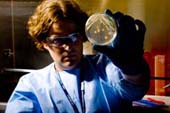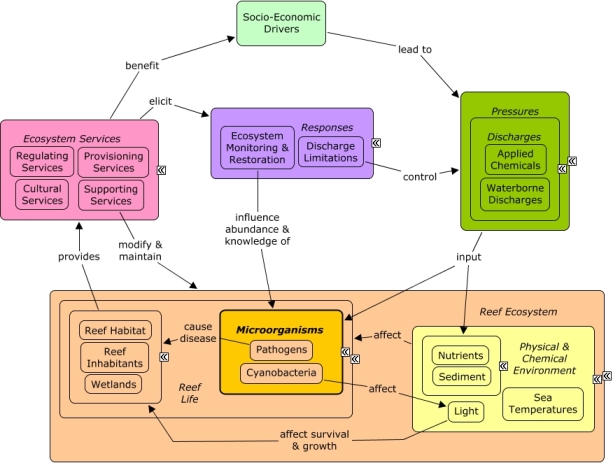ReefLink Database

Pathogens
Pathogens are disease-causing microorganisms, including bacteria, viruses, and fungi.
CMap

CMap Description
Biological inputs of pathogens through wastewater discharges can cause disease in native species. Pathogen growth and disease outbreaks may be accelerated in elevated sea surface temperatures. Changes in reef condition can affect the availability of goods and services. Many of the same socio-economic sectors that benefit from reef ecosystem goods and services also create pressures on reefs through wastewater discharges. Monitoring and scientific research can be used to track blooms and disease outbreaks, and to better understand their impact on reef species. Discharge limitations can control the intensity and frequency of discharges, reducing inputs of nutrients and potential pathogens into the environment.Citations
More than 50 citations. Click here to load.
| Citation | Year | Study Location | Study Type | Database Topics |
|---|
Management Options
| Management Option | Description | Sources | Database Topics |
|---|---|---|---|
| Agriculture & Aquaculture: Livestock Waste Storage and Utilization | Confined animal facilities often produce large amounts of animal waste. This waste can be stored and disposed of in a variety of ways, and it is important to consider how rainwater may carry these wastes in groundwater. Wastes can be kept in temporary storage ponds, storage structures, or treatment lagoons. Once composted, these wastes may be applied to agricultural land in an environmentally acceptable manner in place of other fertilizers. Site selection, timing of application and rate of application must be properly managed to reduce the potential for degradation of ground water. Additionally, this practice may increase microbial action in the soil surface, which helps keep pesticides and other pollutants in place. | Environmental Protection Agency Office of Water. 1993. Guidance Specifying Management Measures For Sources Of Nonpoint Pollution In Coastal Waters. EPA/840/B-92/002, US EPA, Washington, DC. |
Agriculture; Agriculture, Aquaculture, & Forestry Policies; Discharge Limitations; Discharges; Food & Raw Materials; Microorganisms; Non-point Source Controls; Non-point Source Runoff; Nutrients; Pathogens; Waterborne Discharges |
| Monitor & Research: Biological Status and Trends Monitoring | This activity produces long-term comprehensive information on sanctuary-wide status and trends of biological resources. Data that could be collected on coral reef communities includes but is not limited to species abundance and density, biodiversity, benthic cover, coral condition, growth, recruitment, predation, and grazing. Mangroves and seagrasses should also be monitored. With adequate baseline data, changes in community structure and biocriteria can be identified and restoration or protection efforts can be taken. | NOAA Marine Sanctuary Program. 2007. Florida Keys National Marine Sanctuary revised management plan. National Ocean Service, Key West, FL. |
Algae; Anemones & Zooanthids; Apex Fish Predators; Aquaculture; Aquarium Stock; Biochemical & Genetic Resources; Biocriteria; Biological Harvest; Biological Monitoring & Restoration; Biological Monitoring, Mapping, & Scientific Research; Bivalves; Calcareous Macroalgae; Contact Uses; Coral; Coralline Algae; Cyanobacteria; Decision Support; Echinoderms; Ecosystem Monitoring & Restoration; Finfish & Shellfish Stock; Fish; Fishing Sector; Food & Energy Policies; Hydrocoral; Invasive Species; Invertebrates; Large Herbivorous Fish; Lobster, Crab, & Shrimp; Mangroves; Marine Birds; Marine Products; Marine Vertebrates; Marine Worms; Microorganisms; Molluscs; Octocoral; Octopus & Squid; Ornamental Jewelry & Art; Pathogens; Pharmaceuticals & Cosmetics Sources; Physical Damage; Primary Production; Provisioning Services; Resource Use Management; Sea Turtles; Sea Urchins; Seagrasses; Seastars; Skeletal Coral; Small Herbivorous Fish; Snails & Conch; Sponges; Stony Coral; Tunicates; Wetlands; Whales & Dolphins |
| Water Quality Management: Reduce Pollution & Discharges from Marinas & Live-Aboards | This management option strives to reduce and eliminate the discharge of wastewater and pollution within zones near corals. In many instances, "no-discharge" zones already exist and are simply poorly enforced. In other instances the discharge limits are not stringent enough. Successful regulation requires marinas to be equipped with the proper infrastructure to support transfer of wastewater from vessels to shore-side for treatment. This infrastructure includes: pump-out facilities and mobile pump-out services. | NOAA Marine Sanctuary Program. 2007. Florida Keys National Marine Sanctuary revised management plan. National Ocean Service, Key West, FL. |
Biological Addition; Boating Activities; Boating Regulations; Coastal Engineering; Cyanobacteria; Discharge Limitations; Discharges; Docks & Marinas; Health; Health Policies; Marine Debris; Microorganisms; Nutrient & Contaminant Processing; Nutrients; Pathogens; Physical Damage; Point & Mobile Source Controls; Point Source Discharges; Ports & Harbors; Resource Use Management; Sewage Treatment; Solid Waste Disposal; Waste Management; Waste Management Policies; Wastewater Discharge; Waterborne Discharges |
| Water Quality Management: Pet Waste Cleanup Ordinance & Education | In residential areas, pet waste can contributes to the large amount of nutrients and pathogens that enter the water through stormwater runoff. This is especially useful in regions such as Gu�nica, Puerto Rico where there are a lot of stray dogs. Education for pet-owners and possible ordinance would help decrease harmful pathogens reaching corals through stormwater runoff and reduce eutrophication. | Center for Watershed Protection. 2008. Guanica Bay watershed management plan. Natural Resources Conservation Service. Animal Waste Collection. Urban BMP's - Water Runoff Management Accessed 3/18/2011. Clary, J., Leisenring, M., and Jeray, J. 2010. International Stormwater Best Management Practices (BMP) Database. Pollutant Category Summary: Fecal Indicator Bacteria. Wright Water Engineers. |
Aquarium & Pet Trade; Biological Addition; Chemical Variables; Cultural Policies; Cultural Services; Culture; Cyanobacteria; Discharge Limitations; Discharges; Domestic Animal Waste; Environmental Education & Outreach; Health; Health Policies; Invasive Species; Landscaping & Household Services; Microorganisms; Nutrients; Pathogens; Shelter; Solid Waste Disposal; Stormwater Management; Waste Management; Waste Management Policies; Water; Water Resources; Water Utilities Policies; Waterborne Discharges |
Laws
| Legal Citation | Purpose of Law | Management Organization | Database Topics |
|---|---|---|---|
| Marine Sanitation Devices (MSDs); Regulations to establish a No Discharge Zone (NDZ) for State waters within the boundary of the Florida Keys National Marine Sanctuary,Code of Federal Regulations § 40 CFR Part 140, 67 FR 35735. | US EPA established a no discharge zone within the boundaies of the FKNMS pursuant to section 312 (f) (4) (a) of the Clean Water Act. Application to Coral Reefs:Prohibition of waste discharges protects reefs system from eutrophication by the nutrients in waste (particularly nitrogen and phosphorus) as well as the debris and sediment in the waste. Legislative Actions: Comments: |
US Environmental Protection Agency Jurisdiction: US Coral Reefs; US Federal Waters; State Coastal Waters; Designated Marine Areas |
Algae; Ballast Discharge; Commercial Fishing Boats; Cruise Ships; Large Ships; Marine Debris; Nutrient & Contaminant Processing; Nutrients; Oil & Gas Tankers; Pathogens; Petroleum Spills; Physical & Chemical Water Quality Criteria; Small Boats; Waste Management Policies; Wastewater Discharge |
